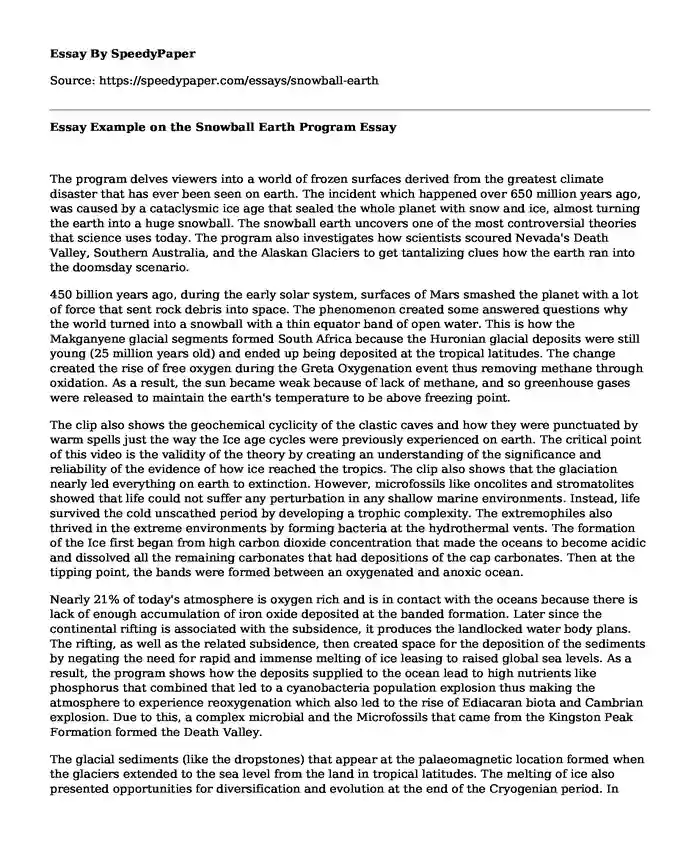The program delves viewers into a world of frozen surfaces derived from the greatest climate disaster that has ever been seen on earth. The incident which happened over 650 million years ago, was caused by a cataclysmic ice age that sealed the whole planet with snow and ice, almost turning the earth into a huge snowball. The snowball earth uncovers one of the most controversial theories that science uses today. The program also investigates how scientists scoured Nevada's Death Valley, Southern Australia, and the Alaskan Glaciers to get tantalizing clues how the earth ran into the doomsday scenario.
450 billion years ago, during the early solar system, surfaces of Mars smashed the planet with a lot of force that sent rock debris into space. The phenomenon created some answered questions why the world turned into a snowball with a thin equator band of open water. This is how the Makganyene glacial segments formed South Africa because the Huronian glacial deposits were still young (25 million years old) and ended up being deposited at the tropical latitudes. The change created the rise of free oxygen during the Greta Oxygenation event thus removing methane through oxidation. As a result, the sun became weak because of lack of methane, and so greenhouse gases were released to maintain the earth's temperature to be above freezing point.
The clip also shows the geochemical cyclicity of the clastic caves and how they were punctuated by warm spells just the way the Ice age cycles were previously experienced on earth. The critical point of this video is the validity of the theory by creating an understanding of the significance and reliability of the evidence of how ice reached the tropics. The clip also shows that the glaciation nearly led everything on earth to extinction. However, microfossils like oncolites and stromatolites showed that life could not suffer any perturbation in any shallow marine environments. Instead, life survived the cold unscathed period by developing a trophic complexity. The extremophiles also thrived in the extreme environments by forming bacteria at the hydrothermal vents. The formation of the Ice first began from high carbon dioxide concentration that made the oceans to become acidic and dissolved all the remaining carbonates that had depositions of the cap carbonates. Then at the tipping point, the bands were formed between an oxygenated and anoxic ocean.
Nearly 21% of today's atmosphere is oxygen rich and is in contact with the oceans because there is lack of enough accumulation of iron oxide deposited at the banded formation. Later since the continental rifting is associated with the subsidence, it produces the landlocked water body plans. The rifting, as well as the related subsidence, then created space for the deposition of the sediments by negating the need for rapid and immense melting of ice leasing to raised global sea levels. As a result, the program shows how the deposits supplied to the ocean lead to high nutrients like phosphorus that combined that led to a cyanobacteria population explosion thus making the atmosphere to experience reoxygenation which also led to the rise of Ediacaran biota and Cambrian explosion. Due to this, a complex microbial and the Microfossils that came from the Kingston Peak Formation formed the Death Valley.
The glacial sediments (like the dropstones) that appear at the palaeomagnetic location formed when the glaciers extended to the sea level from the land in tropical latitudes. The melting of ice also presented opportunities for diversification and evolution at the end of the Cryogenian period. In normal circumstances, while the sun breaks down hydrogen Peroxide, some remain trapped in the ice. As a result, the glaciers began to melt and then released in the ocean and atmosphere, split into oxygen molecules and water leading to the increase in atmospheric oxygen. This is why today the oasis of liquid exist near the geothermal hotspot as Iceland's which have a point of no return.
References
Science, Naked. 2 Apr. 2014, www.youtube.com/watch?feature=player_detailpage&v=YOLbE8frMrM. Accessed 5 Nov. 2018.
Cite this page
Essay Example on the Snowball Earth Program. (2022, Sep 27). Retrieved from https://speedypaper.com/essays/snowball-earth
Request Removal
If you are the original author of this essay and no longer wish to have it published on the SpeedyPaper website, please click below to request its removal:
Popular categories





